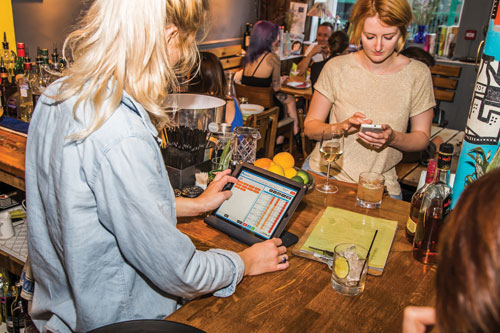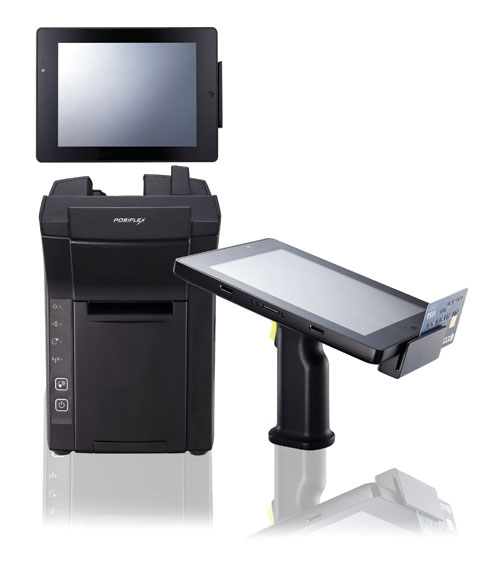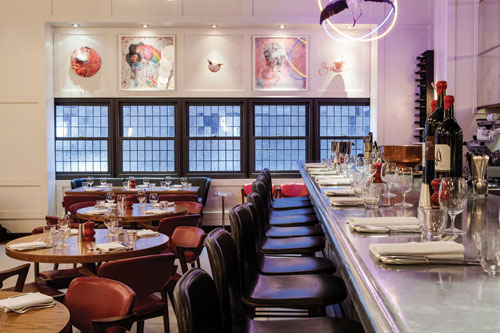The future of EPoS: slow and steady
Increasingly, electronic point of sale systems are moving to the cloud and integrating with mobile pay, but operators shouldn't try to do too much too quickly. Elly Earls finds out why taking it slow and picking a system that will evolve with the times is the key to success
From their beginnings as tills designed solely to take payment, EPoS systems have evolved hugely over the years to become an integral part of a restaurant operation. "The EPoS used to be a standalone end-point in a restaurant where payment was made. It's now a fully integrated enabler for other areas, linking seamlessly with kitchen management systems, loyalty systems, management reporting and directly with customers," says Tim Brown, senior director at Oracle Hospitality.
Whether they're grabbing a quick sandwich or paying the bill after an evening at a fine-dining restaurant, today's diners don't want to wait, making fast payment solutions crucial. But while mobile payment apps, which allow customers to check, split and pay on their own device at the table - and can now be fully integrated with EPoS systems - are on the way in, keeping it simple could actually be more of a boon for many restaurant operators than investing in apps - at least at this point.
"There are some really great innovations on the horizon - for example, we've just partnered with Zapper, which offers a great mobile payment option based on QR codes that is rapidly growing in popularity - the biggest win is with bog-standard card payments," says EPoS Now chief executive Jacyn Heavens.
"Firstly, you need to kill off slow card terminals. If you're still using dial-up (or slow GPRS phone network) terminals, then you are slowly losing repeat business. Next, if businesses haven't yet signed up to a card provider, or are due for renewal, they should only get contactless ones. Contactless payments within the industry have trebled in the last year. With the limit on contactless payments having gone up to £30 in September, and with Apple Pay growing in popularity, opening up this quick and easy way of paying will only help to improve speed."
Going mobile
Handheld devices for restaurant staff are also helping speed up the entire process for guests. "Mobile point of sale (mPOS) systems are introducing a whole new level of speed, as well as ensuring details are accurate," explains Owen Chen, president and chief executive of Posiflex Technology, which offers a range of mPOS solutions.
"At quick-service restaurants, orders can be placed on tablets in the queue, which reduces waiting time, while at full-service restaurants staff can carry the unit with them anywhere on the premises and orders can be taken instantly, accurately and processed quickly.
"The time savings from waiting staff not moving between customers, the till and the kitchen or bar are huge. In addition, these systems are proving useful in prompting servers to ask customers if they need anything more, or to take orders for desserts. The net effect is that staff are empowered and able to engage on a personal level with customers, and equipped with the means to drive additional sales and encourage customers to return."
Moreover, the latest mobile extensions to EPoS systems are also integrated with restaurants' loyalty programmes. "Take this simple scenario: a regular diner is subscribed to your loyalty programme and has ordered a fantastic bottle of wine, and you've set up a promotional item that says diners qualify for a free glass of Champagne on their next visit if they spend more than £100 on wine," says Luis de Souza, chief executive NFS Technology Group. "Your waiter can show the guest what they qualify for because the EPoS system has automatically looked at the bill and checked for loyalty benefits."
Servers can use mobile EPoS units to inform guests of which allergens are present in their dishes, too. "You can have product information behind the button on the tablet so you can tell someone which allergens are present without having to go back and ask the manager," explains Darren Brown, marketing manager at GA Wedderburn. "Or you can put an alert on a table (for example, if someone is allergic to nuts) so if they order other items later, which contain nuts, the system will come up with an alarm."
When using mobile units with EPoS systems, there are a couple of things operators need to take into account, however. One: that they're user-friendly for staff, and two: that they're robust.
"We're now on our third generation of handheld ordering device; with the first generation device, there were too many clicks," recalls de Souza. "We've been through that learning experience now and our new unit is intuitive, with large buttons and a slickly designed user interface. You have to give the waiter the right tools to do a great job."
These devices must also be fit for purpose, stresses Chen. "Consumer-grade tablets are not designed to be used in a restaurant or in foodservice applications. Their battery life and fragility are not reliable during an eight-hour shift. Alternatively, rugged, commercial devices are proven to be hospitality-friendly, and they are designed to be backward-compatible with applications and accessories, and upgradeable to keep up with technological innovation."
EPoS systems are increasingly being hosted on the cloud rather than locally, giving operators advantages including reduced infrastructure costs, better security and the ability to check up on their business in real time, wherever they are.
The latest systems also provide the data which can reveal the most popular meals, peak trade times, average spend and emerging consumer trends. Moreover, unlike traditional on-site systems where upgrades and security patches needed to be undertaken at each payment terminal, cloud-based solutions mean that upgrades can be applied quickly, consistently and enterprise-wide, adds Brown.
There are still drawbacks to moving entirely to the cloud, however, as Clive Consterdine, Zonal Retail Data Systems' sales and marketing director, is keen to stress. "Cloud-based systems are the future, offering access to live information from a central database and rationalisation of hardware," he says.
"However, the appetite for cloud-based technology is running ahead of national infrastructure. Getting a balance of systems that can cover both a local managed network, which is reliable and robust, complemented by cloud-based technology, we believe offers the best of both worlds for operators."
Brown adds: "A good cloud solution will host the products in the cloud, but allow operations to continue offline."
EPoS systems are advancing fast, and while it may not quite be the norm for customers to order and pay via their smartphone and operators view critical real-time information about their business on the move, cloud-based systems and mobile-app integration are undoubtedly the future.
"We might even see more from Google Glass - with orders being transmitted from the EPoS direct to the chef's glasses! And how long will it be before we find a waiter-free restaurant in the UK?" asks Brown.
In the meantime, however, operators need to take things slow and pick an EPoS system that can grow with their business and evolve with the times. "If caterers are prepared to invest, they should ensure it will still be relevant in a few years' time or easily upgraded," concludes Chen.
HIX and Aloha
London operator HIX Restaurants chose NFS Technology Group's Aloha PoS software and web portals to not only improve control and mobility across its eight sites, but also because the restaurant group wanted a solution that would grow with the business.
The solution HIX opted for includes the NFS Aloha EPoS with its multi-site web reporting platform and a mobile reporting solution also offered by the provider called Aloha Pulse. And according to purchasing and food and beverage manager for HIX Restaurants Group Andrew Vine, this combination really does allow the team to get an entire picture of how all the group's restaurants are running.
"Ultimately, the multi-level Aloha functionality will simplify administration tasks so that we can run our restaurants even more efficiently than before," he says, summing up that Aloha's flexibility will also allow the team to integrate even more tasks into the software in the future, allowing the technology integration to evolve with the group as it grows.
Three ordering options on offer at Burrito Mama
Wahaca's new brands Burrito Mama and DF Mexico feature technology that allows customers to order using self-service kiosks, through its app and using manned terminals.
The idea is that customers can order, pay upfront and collect their food. To facilitate integration of all three options, Wahaca has employed a TISSL system, which came to the rescue after the original supplier at Burrito Mama failed to deliver.
"We needed to change tack, fast," explains Wahaca's head of development Gavin Adair. "We were introduced to TISSL, who were very quick to pick up the challenge. By then, we'd decided to develop our own mobile app, and TISSL committed to integrate it with their EPoS and with our QSR software to build an all-encompassing solution."
Adair adds that a third of customers now use the self-service option, with 10% using the app and the rest cashiers. "We wanted to offer clients a choice," he says.
The same technology solution has been employed at DF Mexico, where its integration with the kitchen has been key to its success.
Feed it back
A new EPoS add-on, which combines guest feedback with live EPoS information about exactly what happened during their visit, has been met with great feedback of its own.
"We regularly hold industry round-table events with operators, experts and representatives from a range of hospitality businesses. We worked with Oracle to demonstrate just what could be achieved with EPoS-linked feedback. The response was amazing, particularly around the interface and focus on the customer, and showed us that we'd produced something really quite special," says Feed It Back's head of product Kevin Davies.
For operators, it's a straightfoward application to integrate. "Switching on EPoS-linked feedback is just a couple of clicks," Davies explains. "Once integrated, the power is immediately obvious - not only is it possible to see the feedback within the context of the guest's visit, but asking specific questions shows the customer you value their time, while still gaining real insight for those critical decisions."














